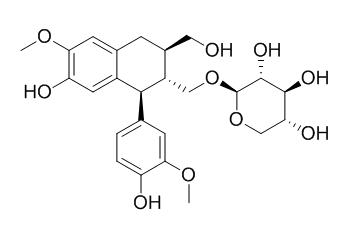Schizandriside
Schizandriside may have anti-inflammatory effects, it has inhibitory activities against nitric oxide and prostaglandin E(2) production in IFN-γ- and lipopolysaccharide-stimulated RAW 264.7 cells. It shows significant cytotoxicity against A549, SK-OV-3, SK-MEL-2, and HCT-15 cell lines with inhibitory concentration (IC50) values of 3.26-8.89 uM.
Inquire / Order:
manager@chemfaces.com
Technical Inquiries:
service@chemfaces.com
Tel:
+86-27-84237783
Fax:
+86-27-84254680
Address:
1 Building, No. 83, CheCheng Rd., Wuhan Economic and Technological Development Zone, Wuhan, Hubei 430056, PRC
Providing storage is as stated on the product vial and the vial is kept tightly sealed, the product can be stored for up to
24 months(2-8C).
Wherever possible, you should prepare and use solutions on the same day. However, if you need to make up stock solutions in advance, we recommend that you store the solution as aliquots in tightly sealed vials at -20C. Generally, these will be useable for up to two weeks. Before use, and prior to opening the vial we recommend that you allow your product to equilibrate to room temperature for at least 1 hour.
Need more advice on solubility, usage and handling? Please email to: service@chemfaces.com
The packaging of the product may have turned upside down during transportation, resulting in the natural compounds adhering to the neck or cap of the vial. take the vial out of its packaging and gently shake to let the compounds fall to the bottom of the vial. for liquid products, centrifuge at 200-500 RPM to gather the liquid at the bottom of the vial. try to avoid loss or contamination during handling.
Front Pharmacol.2023, 14:1095083.
Front Pharmacol.2019, 10:1226
Appl Biochem Biotechnol.2020, 190(2):732-744
Food and Bioprocess Technology2017, 10(6):1074-1092
J Agric Food Chem.2024,72(37):20396-20409.
LWT2021, 138:110630.
J Ethnopharmacol.2018, 210:88-94
Journal of Apicultural Research2021, 60(1)
Pharmaceuticals (Basel).2021, 14(10):1046.
Molecules.2019, 24(16):E3003
Related and Featured Products
Food Chem Toxicol. 2012 Oct;50(10):3680-6.
Lignan constituents of Tilia amurensis and their biological evaluation on antitumor and anti-inflammatory activities.[Pubmed:
22819933]
In the recent decade, numerous lignan derivatives isolated from plants have been proven to have the potential as an anti-cancer substance.
METHODS AND RESULTS:
On the search for anti-cancer compounds from Korean medicinal plants, the methanolic extract from the trunk of Tilia amurensis Rupr. (Tiliaceae) was found to have significant cytotoxicity against A549 (lung carcinoma), SK-OV-3 (ovary malignant ascites), SK-MEL-2 (skin melanoma), and HCT-15 (colon adenocarcinoma) in our screening test. Hence, a bioassay-guided fractionation and chemical investigation of the methanolic extract resulted in the isolation and identification of 10 lignan derivatives (1-10) including two new lignan glycosides named tiliamurosides A (1) and B (2). The structures of these new compounds were determined by spectroscopic methods, namely 1D and 2D nuclear magnetic resonance (NMR) techniques, high resolution mass spectrometry (HRMS), circular dichroism (CD) data, and chemical methods.
CONCLUSIONS:
Tiliamuroside B (2) and Schizandriside (3) showed significant cytotoxicity against A549, SK-OV-3, SK-MEL-2, and HCT-15 cell lines with inhibitory concentration (IC50) values of 3.26-8.89 μM. Moreover, (-)-syringaresinol (8) and (-)-pinoresinol 4-O-β-D-glucopyranoside (10) significantly inhibited nitric oxide (NO) production in murine microglia BV-2 with IC50 values of 15.05 and 34.35 μM, respectively.
Arch Pharm Res. 2010 Dec;33(12):2011-6.
Inhibitory effects of phenolic compounds from needles of Pinus densiflora on nitric oxide and PGE2 production.[Pubmed:
21191767 ]
The needles of Pinus densiflora Siebold et Zuccarini, a representative Pinus species that grows in Korea, have been used in oriental traditional medicine as remedies for rheumatitis, hemorrhage, cancer, etc.
METHODS AND RESULTS:
Phytochemical examination of the needles of Pinus densiflora Siebold et Zuccarini led to the isolation of four lignans, one flavan-3-ol, two flavonols and one organic acid. They were identified as icariside E(4) (1), cupressoside A (2), Schizandriside (3), (+)-isolariciresinol (4), (+)-catechin (5), quercetin 3-O-β-D-glucopyranoside (6), 5,7,8,4'-tetrahydroxy-3-methoxy-6-methylflavone 8-O-β-D-glucopyranoside (7) and (-)-shikimic acid (8).
CONCLUSIONS:
In order to evaluate the anti-inflammatory effects of these compounds, their inhibitory activities against nitric oxide and prostaglandin E(2) production in IFN-γ- and lipopolysaccharide-stimulated RAW 264.7 cells were examined.
J Med Food. 2011 Jul-Aug;14(7-8):834-9.
Secondary metabolites of Miconia rubiginosa.[Pubmed:
21480804 ]
The Miconia genus is the most representative of the Melastomataceae family, and some species are commonly used in Brazilian folk medicine as anti-inflammatory agents.
METHODS AND RESULTS:
In this work we investigated the leaves from Miconia rubiginosa (Bonpl.) DC, using high-speed countercurrent chromatography, which yielded 11 substances (eight flavonoids, gallic acid, casuarictin, and Schizandriside).
CONCLUSIONS:
Identification was achieved using nuclear magnetic resonance spectroscopy and high-performance liquid chromatography-circular dichroism-diode array detection analyses.



